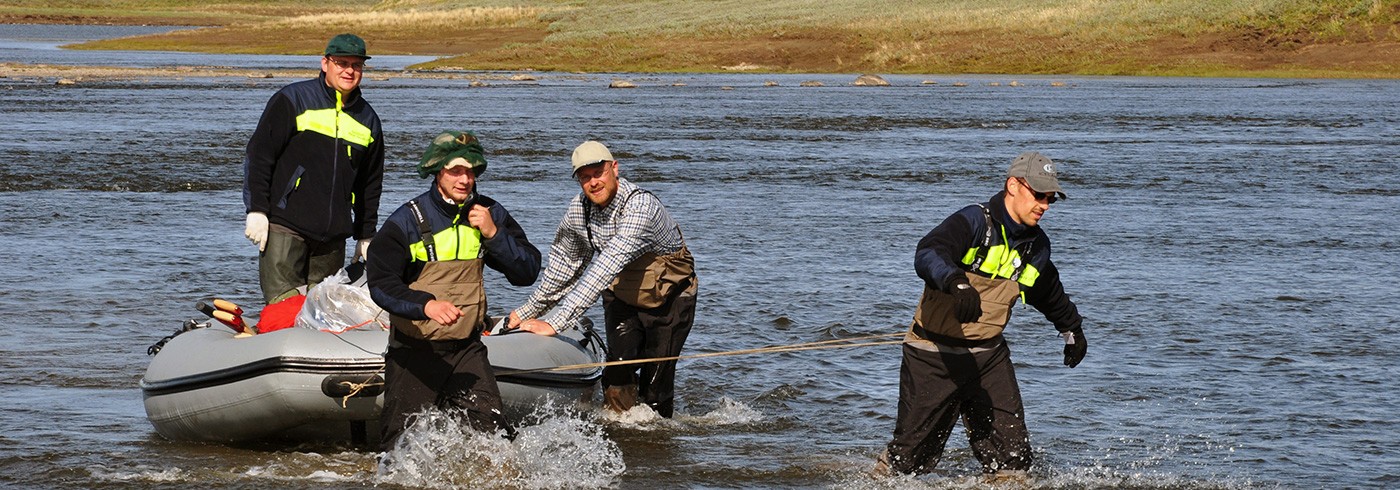
The church in Khatanga at sunset. Photo: Per Möller
Friday morning, the 20th of August in Lund. Sitting on my terrace surrounded by vines, my olive, lemon and orange trees, and the clay pots filled with thriving lemon verbena, pineapple sage and basil. Tomatoes ripening in abundance. What another world than the Taymyr Peninsula, only 8 flight hours away in a number of different air planes! All expedition members are at home, safe and sound together with their loved ones.
After a lively dinner last Sunday evening together with the bedrock geology group, Monday morning was a bit tough for some expedition members. But in the nicest weather we started the two-day job with sorting up all expedition gear that directly went for sale to the locals in Khatanga – it did not take long until the zodiacs were gone at reasonable prices.
And then all the samples, for the Quaternary group close to 300 kilos. The process of getting these out of Russia, which in best cases will be somewhere in early November, is a very bureaucratic process, the first step being to provide the local police chief with a detailed list of samples in each packed box, together with sample description and purpose of the sample. Later in St Petersburg these samples have to pass some kind o geologic committee – complemented with an even more detailed sample description list – for getting the final export permission. And Khatanga is Khatanga – a personal love and hate relation. The first time I visited Khatanga was in 1996, and after a rainy week, everything in deep mud and constant lousy food, I promised myself never Russia again. This was the fifth time in arctic Siberia…

Khatanga as it really looks… Photo: Per Möller
Khatanga is so ugly with all worn-down, never renovated houses that people actually live in, and all these abandoned houses with smashed windows and nailed over doors. Electric wires hang in criss-cross patterns and water- and sewage pipes everywhere over ground (cant get them down due to the permafrost), the latter often leaking and giving a foul odour. The roads are constructed of the waste from the coal-fuelled energy plant, giving everything a black hue. But you must admire the group of people still living here and trying to make an outcome in this very harsh environment. And if you close your eyes for the garbage everywhere, sitting on the bank of the Khatanga River at sunset, then you realize that the village has the nicest setting. It could be something else than it is…

Khatanga as it really looks… Photo: Per Möller
Last Wednesday it was check-out time at 5 am from our Khatanga “Hilton” – a kind of hotel it is said. It was time to board the once-a week airplain to Norilsk, where we were supposed to stay the night for the final leg home. Norilsk in a “closed” city due to its strategic importance, its mines being the largest nickel producer in Russia. Thus permissions to go there for foreigners are hard to get, and papers are controlled and discusses in a large detail both at arrival and departure. Norilsk is a town with some 300 thousand inhabitants, lying there on the tree tundra without any land-based infrastructure connection to the rest of Russia. The only road and railway leads to Dudinka, settled at the Yenisei River, from which all the extracted minerals are shipped out. From the airport and into the city it is a devastating sight of a number of agglomerated high chimneys, puking out heavy smoke, and a totally ruined landscape. The spread-out larch trees are standing there on the tundra very dead. After a nights stay at a real hotel – meaning showers that provide hot water and functioning toilets, even with toilet paper – there was a four hours flight to Moscow, a chaotic two hours taxi transfer between the Domodedovo and Sheremetyevo airports, and then the final to hours to Copenhagen. We were home after close to seven weeks.

And the nice side of Khatanga, the Khatanga River at sunset, the 17th of August, 2010. Photo: Per Möller
In retrospective, it must be concluded that the expedition was a success, at least when it comes to performed field work. The scientific success will show first in more than a year when we have performed all datings and other analyzes on our numerous samples. We travelled the Bolshaya Balakhnya River as planned from its headwaters for some total 440 km to our last base camp along the river. The planned last leg trough the delta area and then the 70 km transport over Khatanga Bay to the Novorybrovne had to be cancelled, however. We have investigated 17 main sites, of which most are previously described sites from earlier Russian work that now will be reviewed in light of modern sedimentological thinking and new dating methods. The research group, which consisted of three new members that never had worked together before, and some of them having not so much experience from work in a harsh arctic environment, and for a long time period, functioned surprisingly well. All were individuals with their peculiarities, but all fitted well into a group in which there always was a good mood and good humour even when it sometimes went rough – both with weather, long hours, hard work on shallow rivers, and technique that not always was on our side. Thanks to you all!
Now we are waiting for a second expedition for this research project, hopefully in 2012. The concept is the same, river rafting, but this time further to the west, from the head waters of the mighty Upper Taymyr River down to Lake Taymyr.
Per Möller, Department of Geology, Lund University

